The American National Standards Institute (ANSI) is a private, not-for-profit organization. Z80.1 is a reference for creating safe and effective eyewear.
I am a national speaker for ABO-NCLE. I travel throughout the US to give ABO reviews for candidates preparing to take the ABO exam. What I find surprising is the number of apprentice opticians who have seen the ANSI Z80.1 standards, but have no clue how they apply to eyewear. In addition, they do not inspect eyewear to ANSI standards. Therefore, I spend time during the review courses breaking down how they apply to eyewear.
Let’s break down ANSI so you can understand it.
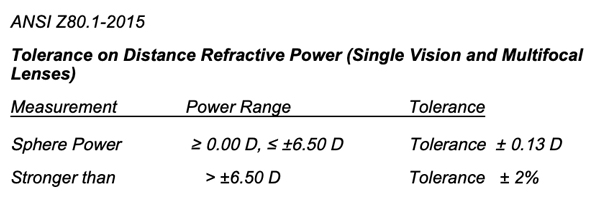
The tolerance for distance refractive power of single vision and multifocal lenses ranging in power from a -6.50 to +6.50 (Sphere Power ≥ 0.00 D, ≤ ±6.50 D ) is + or - 0.13D. What does that mean?
For example:
OD: -5.75-1.50X180
OS: -5.50-1.50X180
It means that in regard to sphere power only when inspecting eyewear, you have a tolerance of + or -0.13 D. For this pair of glasses, the tolerance for sphere power only, OD -5.75, is -5.62 to -5.88, and acceptable to pass. The tolerance for sphere power only OS -5.50, is -5.37 to -5.63 and acceptable to pass.
For any power over + or - 6.50, there is a tolerance of 2% of the sphere power only.
For example:
OD: -8.75-1.50X180
OS: -7.50-1.50X180
It means that in regard to sphere power only when inspecting eyewear, you have a tolerance of + or -2%. For this pair of glasses, the tolerance for sphere power OD -8.75, is -8.58 to -8.92 (2 % of 8.75 is .17 D), and acceptable to pass. The tolerance for sphere power OS: -7.50, is -7.35 to -7.65 (2 % of 7.50 is .15 D), and acceptable to pass.

For cylinder power of single vision and multifocal lenses ranging in power from -2.00 to +2.00 (Cylinder Power ≥ 0.00 D, ≤ 2.00) the tolerance is + or - 0.13D. What does that mean?
For example:
OD: -5.75-1.50X180
OS: -5.50-1.50X180
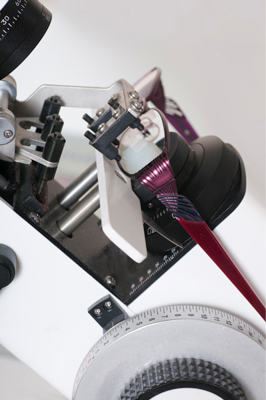 |
It means that in regard to cylinder power only when inspecting eyewear, you have a tolerance of + or -0.13 D. For this pair of glasses, cylinder power OD/OS: -1.50, the tolerance is -1.37 to -1.63, and acceptable to pass.
The tolerance for cylinder power of single vision and multifocal lenses ranging in power between
± 2.00 to ± 4.50 (Cyl Power > 2.00 D, ≤ 4.50 ) is +or - 0.15D. What does that mean?
For example:
OD: -5.75-3.75X180
OS: -5.50-3.75X180
It means that in regard to cylinder power only when inspecting eyewear, you have a tolerance of + or -0.15 D. For this pair of glasses, cylinder power OD/OS: -3.75, the tolerance is -3.60 to -3.90, and acceptable to pass.
The tolerance for cylinder power of single vision and multifocal lenses ranging in power above ± 4.50 D (Cylinder Power > 4.50 D) is ± 4% D. What does that mean?
For example:
OD: -5.75-5.25 X180
OS: -5.50-5.25 X180
It means that in regard to cylinder power only when inspecting eyewear, you have tolerance of ± 4% D. For this pair of glasses, cylinder power OD/OS: -5.25, the tolerance is -5.04 to -5.46 (4% D of cylinder power - 5.25 is .21D) and acceptable to pass.

The tolerance for distance refractive power of single vision and multifocal lenses ranging in power from -8.00 to +8.00 (Sphere Power ≥ 0.00 D, ≤ ±8.00 D ) is + or - 0.16D. What does that mean?
For example:
OD: -8.75-1.50X180
OS: -8.50-1.50X180
Add +3.00
It means that in regard to sphere power only when inspecting eyewear, you have a tolerance of + or -0.16 D. For this pair of glasses, OD: -8.75, the tolerance for sphere power is -8.59 to -8.91, and acceptable to pass. The tolerance for sphere power OS: -8.50, is -8.34 to -8.66, and acceptable to pass.
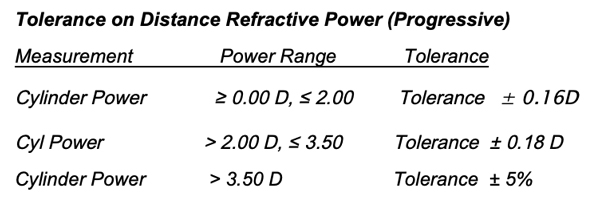
The tolerance for cylinder power of progressive lenses ranging in power from a -2.00 to +2.00 (Cylinder Power ≥ 0.00 D, ≤ 2.00) is + or - 0.16D. What does that mean?
For example:
OD: -5.75-1.50X180
OS: -5.50-1.50X180
It means that in regard to cylinder power only when inspecting eyewear, you have a tolerance of + or -0.16 D. For this pair of glasses, the tolerance for cylinder power OD/OS: -1.50, is -1.34 to -1.66, and acceptable to pass.
The tolerance for cylinder power of progressive lenses ranging in power between
± 2.00 to ± 3.50 (Cyl Power > 2.00 D, ≤ 3.50) is +or - 0.18D. What does that mean?
For example:
OD: -5.75-2.75X180
OS: -5.50-2.75X180
It means that in regard to cylinder power only when inspecting eyewear, you have a tolerance of + or -0.18 D. For this pair of glasses, the cylinder power OD/OS: -2.75, the tolerance is -2.57 to -2.93, and acceptable to pass.
The tolerance for cylinder power of progressive lenses ranging in power above ± 3.50 D (Cylinder Power > 3.50 D) is ± 5% D. What does that mean?
For example:
OD: -5.75-5.25 X180
OS: -5.50-5.25 X180
It means that in regard to cylinder power only when inspecting this eyewear, you have tolerance of ± 5% D. For this pair of glasses, OD/OS: -5.25, the tolerance is -4.99 to -5.51, (5% of cylinder power - 5.25 is .26D) and acceptable to pass.
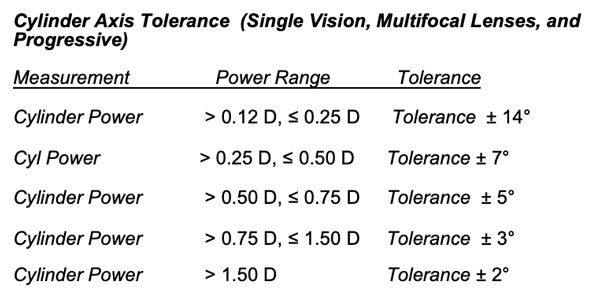
The tolerance for the axis is based on the power of the cylinder only. What does that mean?
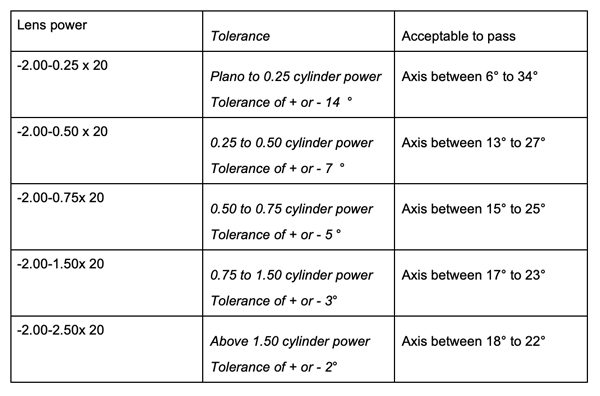
You can learn more about lens power and the patient’s prescription with our CE, Shouldn't Lens Effective Power Be Equal to Your Prescription, at 2020mag.com/ce.













